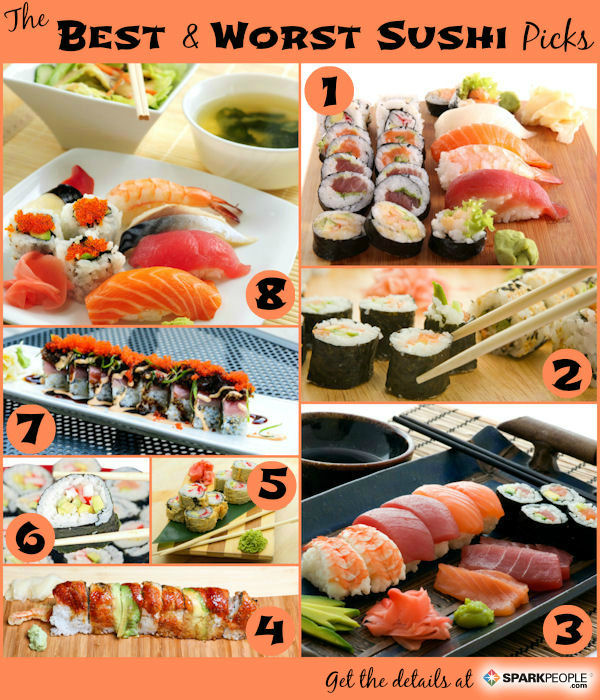Sushi, in its traditional form, is rice and fish, which makes it a light and lean meal option. However, as sushi's popularity proliferated in the West, some of its health benefits were lost in translation. All-you-can-eat sushi, deep-fried rolls, and fancy mayo-based sauces overtook the artistic simplicity of this iconic Japanese food.
The menus at sushi restaurants are lengthy and, for novices, intimidating. Fun names like "Spider Rolls" and unfamiliar foreign words like "futomaki" only add to the confusion. Many people are so confused they often ask the question "Is sushi healthy?".
To make your sushi experience as stress-free and healthy as possible, we're helping you navigate the menu, highlighting the best and worst choices you're likely to encounter. Plus, we translate the most common Japanese words you'll encounter--and offer our "best practice" tips for leaving the restaurant sated, not stuffed.
Tips for Ordering Healthy Sushi
- Skip the tempura rolls. "Tempura" is code for "fried"! Plus, the crisp texture becomes mushy when wrapped in a roll.
- Forgo rice. Some restaurants can create rice-free wraps and instead use cucumber, soy-based wraps or just nori (seaweed). Ask your server if any such alternatives are available.
- Limit the avocado. Though the fat in avocados is heart-healthy, the calories do add up fast. Also, the avocado flavor is often lost when combined with other ingredients.
- Choose cucumber, carrots, and scallions. For crunch and flavor for almost no calories, ask for extra veggies in any roll.
- Stick to two rolls. Though each roll only has 8-10 bites, they contain up to 400 calories each, thanks to the cup of sushi rice in each one. Get one fancy roll and one basic roll, add miso soup or a simple salad, and you'll be plenty full.
- Ask for hand rolls. Hand rolls (temaki) are cones of seaweed with a bit of rice and all the fillings of a traditional roll. You can save up to 80 calories per roll by asking for hand rolls.
- Choose brown rice. You won't notice much of a difference in taste, but you'll get a bit of added fiber.
- Stick with the basics. Fancy rolls tend to pile on caloric extras like cream cheese, tempura coating, and mayonnaise. Choose fish, rice, and vegetables for a lighter meal.
- Get the appetizer-size sashimi platter. Slices of raw fish are a great choice, but the typical platter has at least three servings. Share with a friend or get the appetizer portion.
- For spice, choose wasabi. Spicy sauces are usually mayonnaise based, so choose wasabi instead to save calories.
- Go easy on the soy sauce. Choose low-sodium soy sauce, but use it sparingly. A tablespoon of low-sodium soy sauce still has 25% of your daily sodium.
- Don't fill your soy sauce cup. Sushi comes to you pre-seasoned, so the added saltiness of soy sauce can mask the delicate taste of the fish. If you really want extra salt on your rolls, don't fill up the dipping cup. Instead, top each bite with a drop or two of soy sauce as you eat.
- If you're watching your sodium, know where it's hiding. Miso soup is a low-calorie option, but it can be salty. Most brown sauces, including the sweet-and-salty sauce that comes on grilled eel and the dipping sauce for tempura, can also be high in sodium.
Know the Lingo:
- Futomaki: a thick roll, usually cut into eight pieces. Specialty rolls are usually futomaki.
- Hosomaki: thin roll with just one type of filling. Single-ingredient rolls such as salmon, tuna, or cucumber rolls are usually hosomaki.
- Uramaki: a roll with the nori (seaweed) on the inside and rice on the outside. Sometimes called an inside-out roll.
- Temaki: Also called a hand roll, this is a cone-shaped nori roll with the ingredients and minimal rice inside.
Let's run through a typical sushi menu to highlight the best choices, along with those you should limit.
Appetizers
| Choose |
Limit |
Green Salad: Spring greens, lettuce and carrots with ginger dressing
50 calories, 1 g fat (1 cup salad)
Seaweed Salad: Seaweed, sesame seeds, spices on top of fresh cucumber
70 calories, 4 g fat (1/2 cup)
Miso Soup: Miso broth with bits of tofu, seaweed and green onions
90 calories, 2 g fat (1 cup)
Salmon or Tuna Tataki: seared fish topped with ponzu (citrus) sauce served over daikon radish
160 calories, 6 g fat (4 ounces)
Shumai: Steamed dumplings filled with meat, seafood or vegetables. 105 calories, 2 g fat (4 dumplings)
Edamame: Steamed young soybeans in their pods
100 calories, 3 g fat (1/2 cup shelled) |
Tempura: Deep-fried shrimp and/or vegetables with a soy dipping sauce
260 calories, 14 g fat (2 shrimp and 4 pieces of vegetable)
Gyoza: Pan-fried dumplings filled with meat, seafood or vegetables.
140 calories, 6 g fat (4 dumplings) |
Rolls
| Choose |
Limit |
Alaska: Salmon and avocado
300 calories, 9 g fat
Tuna, salmon, shrimp or yellowtail (or any single fish)
175 calories, 2 g fat
Vegetable (or any combo)
135 calories, 0 g fat
Rainbow: Crab, cucumber inside, topped with tuna, yellowtail, salmon, fluke, avocado
476 calories, 16 g fat (Note: This roll is large enough to be a whole meal!)
Yellowtail-Scallion
185 calories, 2 g fat
California: crabstick, avocado, and cucumber
290 calories, 5 g fat (Note: If crab salad, made with mayo, is used instead of crabstick, you'll add more than twice the calories and three times the fat!) |
Shrimp Tempura: Tempura shrimp, cucumber, and avocado
500 calories, 16 g fat
Philadelphia/Bagel: Smoked salmon, avocado and cream cheese
320 calories, 5 g fat
Spider: Fried soft-shell crab, cucumber, avocado and roe (fish eggs)
510 calories, 21 g fat
Spicy Tuna: Chopped tuna, spicy mayonnaise, and crunchy topping
320 calories, 3 g fat "
(Note: Spicy" rolls are often made with trimmings from other rolls that are mixed with a flavored mayo.)
Eel and Avocado: Grilled eel with sweet and salty "eel" sauce and avocado
370 calories, 17 g fat
Salmon Skin: deep-fried salmon skin, "eel sauce" and cucumber
245 calories, 4 g fat |
In deciding which rolls to put on both lists, we considered fat and calories, but also the types of fat and added sugar. Deep-fried rolls, rolls with full-fat cream cheese, and mayo-based fillings, while delicious and innovative, are on the "limit" list. If your fave is on the heavier side, split it with your dining companion, pair it with a lighter roll (such as a plain tuna or cucumber roll), or make it your whole meal. The higher-calorie rolls on the "choose" list are packed with heart-healthy fat, in the form of omega 3s in cold-water fish, or heart-healthy unsaturated fats, in avocado.
Sashimi/Nigiri Sashimi is slices of raw or lightly cooked fish; nigiri is raw fish on mounds of rice. Both are healthy choices; sashimi is ideal for those counting carbs.
Nigiri has about 70 calories per piece (including 1-2 T rice); sashimi has 25-50 calories per piece. Each slice is about 1 ounce of fish; a serving is approximately four slices. The following are some of the most common choices for both sashimi and nigiri:
- Crabstick
- Eel
- Fluke
- Mackerel
- Octopus
- Red snapper
- Salmon
- Salmon roe (eggs)
- Scallop
- Shrimp
- Smoked salmon
- Squid
- Striped bass
- Surf clam
- Tamago (sweet omelet)
- Tuna
- White tuna
- Yellowtail
Pin this graphic for easy reference.

- Focus on quality over quantity. Simple rolls (with fish and vegetables) and sashimi or nigiri are healthy staples that allow the ingredients' freshness to shine.
- Sushi is perfectly seasoned by the chef. Try it without soy sauce and see if you notice any subtle flavors that the saltiness masked.
- Choose cold-water fish like tuna and salmon, which are packed with heart-healthy omega-3 fatty acids.
- Restaurants like to get creative with rolls like this, but all those bells and whistles are just adding extra fat, salt and sugar. The appeal of tempura is the light crispy exterior, which is hidden inside a roll! (The "eel sauce" on top of this roll is packed with sugar and salt.)
- Deep-fried rolls are a fad--one you should bypass. They can have 500-plus calories each!
- California rolls are fully cooked, which makes them a great option for sushi newbies and anyone who doesn’t like or can't eat raw fish, such as pregnant women.
- Most toppings are superfluous and packed with fat. Skip any "crunchy toppings," fried onions and spicy mayo. Roe (fish eggs) are nutritious and add texture, while wasabi adds spice without added fat.
- Make it a meal: Pair a few pieces of sashimi or nigiri with a simple roll, soup and/or salad.
|






.jpg)